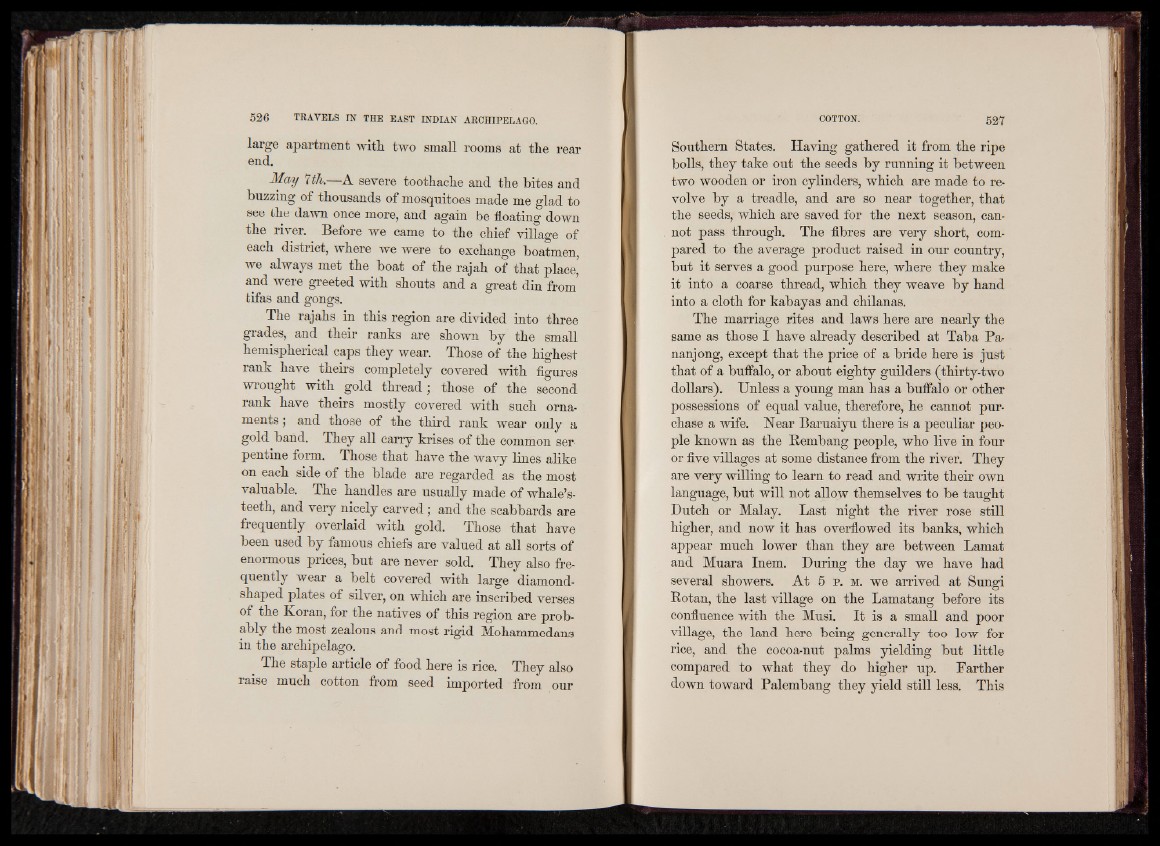
large apartment with two small rooms at the rear
end.
May 7 th.—A severe toothache and the bites and
buzzing of thousands of mosquitoes made me glad to
see the dawn once more, and again be floating down
the river. Before we came to the chief village of
each district, where we were to exchange boatmen,
we always met the boat of the rajah of that place’
and were greeted with shouts and a great din from’
tifas and gongs.
The rajahs in this region are divided into three
grades, and their ranks are shown by the small
hemispherical caps they wear. Those of the highest
rank have theirs completely covered with figures
wrought with gold thread; those of the second
rank have theirs mostly covered with such ornaments
; and those of the third rank wear only a
gold band. They all carry krises of the common ser
pentine form. Those that have the wavy lines alike
on each side of the blade are regarded as the most
valuable. The handles are usually made of whale5 s-
teeth, and very nicely carved; and the scabbards are
frequently overlaid with gold. Those that have
been used by famous chiefs are valued at all sorts of
enormous prices, but are never sold. They also frequently
wear a belt covered with large diamondshaped
plates of silver, on which are inscribed verses
of the Koran, for the natives of this region are prob-
ably the most zealous and most rigid Mohammedans
in the archipelago.
The staple article of food here is rice. They also
raise much cotton from seed imported from our
Southern States. Having gathered it from the ripe
bolls, they take out the seeds by running it between
two wooden or iron cylinders, which are made to revolve
by a treadle, and are so near together, that
the seeds, which are saved for the next season, cannot
pass through. The fibres are very short, compared
to the average product raised in our country,
but it serves a good purpose here, where they make
it into a coarse thread, which they weave by hand
into a cloth for kabayas and chilanas.
The marriage rites and laws here are nearly the
same as those I have already described at Taba Pa-
nanjong, except that the price of a bride here is just
that of a buffalo, or about eighty guilders (thirty-two
dollars). Unless a young man has a buffalo or other
possessions of equal value, therefore, he cannot purchase
a wife. Near Baruaiyu there is a peculiar people
known as the Bembang people, who live in four
or five villages at some distance from the river. They
are very willing to learn to read and write their own
language, but will not allow themselves to be taught
Dutch or Malay. Last night the river rose still
higher, and now it has overflowed its banks, which
appear much lower than they are between Lamat
and Muara Inem. During the day we have had
several showers. At 5 p. m. we arrived at Sungi
Rotan, the last village on the Lamatang before its
confluence with the Musi. It is a small and poor
village, the land here being generally too low for
rice, and the cocoa-nut palms yielding but little
compared to what they do higher up. Farther
down toward Palembang they yield still less. This